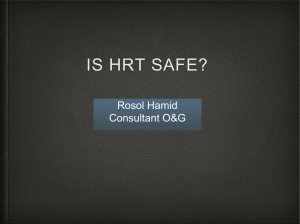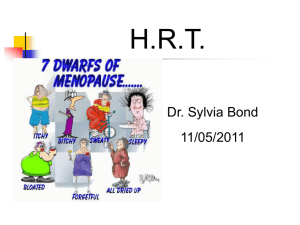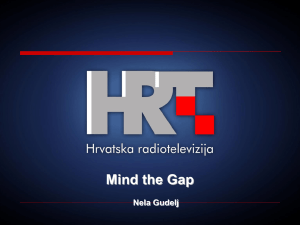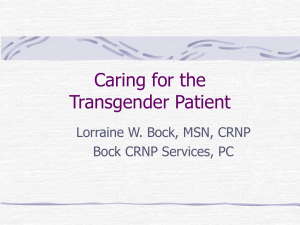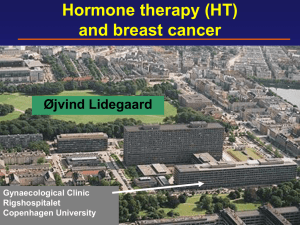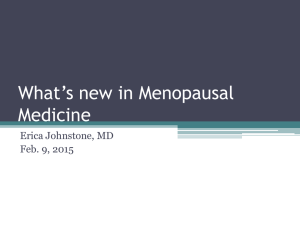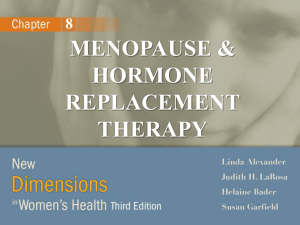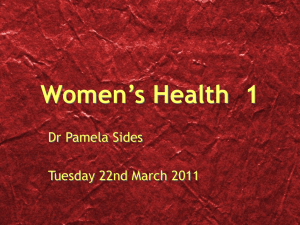Tibolon Orifarm 2,5 mg tablet ENG SmPC
advertisement
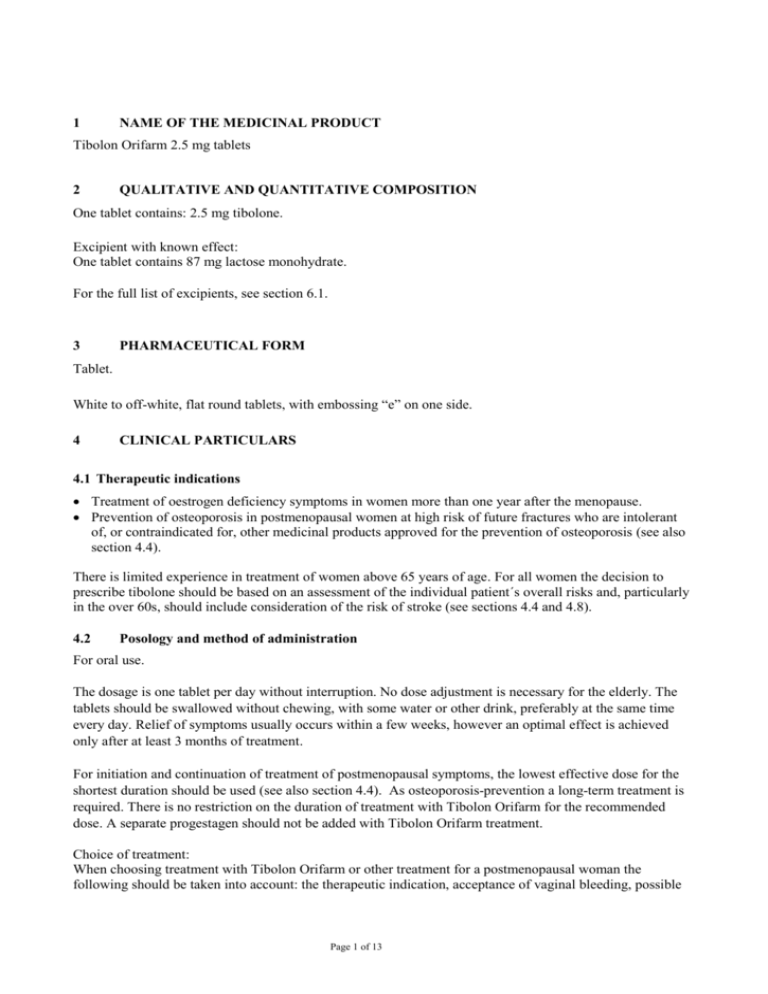
1 NAME OF THE MEDICINAL PRODUCT Tibolon Orifarm 2.5 mg tablets 2 QUALITATIVE AND QUANTITATIVE COMPOSITION One tablet contains: 2.5 mg tibolone. Excipient with known effect: One tablet contains 87 mg lactose monohydrate. For the full list of excipients, see section 6.1. 3 PHARMACEUTICAL FORM Tablet. White to off-white, flat round tablets, with embossing “e” on one side. 4 CLINICAL PARTICULARS 4.1 Therapeutic indications Treatment of oestrogen deficiency symptoms in women more than one year after the menopause. Prevention of osteoporosis in postmenopausal women at high risk of future fractures who are intolerant of, or contraindicated for, other medicinal products approved for the prevention of osteoporosis (see also section 4.4). There is limited experience in treatment of women above 65 years of age. For all women the decision to prescribe tibolone should be based on an assessment of the individual patient´s overall risks and, particularly in the over 60s, should include consideration of the risk of stroke (see sections 4.4 and 4.8). 4.2 Posology and method of administration For oral use. The dosage is one tablet per day without interruption. No dose adjustment is necessary for the elderly. The tablets should be swallowed without chewing, with some water or other drink, preferably at the same time every day. Relief of symptoms usually occurs within a few weeks, however an optimal effect is achieved only after at least 3 months of treatment. For initiation and continuation of treatment of postmenopausal symptoms, the lowest effective dose for the shortest duration should be used (see also section 4.4). As osteoporosis-prevention a long-term treatment is required. There is no restriction on the duration of treatment with Tibolon Orifarm for the recommended dose. A separate progestagen should not be added with Tibolon Orifarm treatment. Choice of treatment: When choosing treatment with Tibolon Orifarm or other treatment for a postmenopausal woman the following should be taken into account: the therapeutic indication, acceptance of vaginal bleeding, possible Page 1 of 13 problems with mood or libido, effects on the breast tissue and the benefit/risk profile. See also sections 4.4 and 5.1. Starting Tibolon Orifarm - Women experiencing a natural menopause should only commence treatment with Tibolon Orifarm at least 12 months after their last natural bleed. If treatment with Tibolon Orifarm is introduced earlier the risk of irregular vaginal bleeding or spotting is increased. - Women experiencing a surgical or chemical introduced menopause may commence treatment with Tibolon Orifarm immediately. Any irregular/unscheduled vaginal bleeding, either on or off HRT, for which there is no obvious cause, should be investigated to exclude malignancy before starting Tibolon Orifarm (see section 4.3). Switching from a sequential or continuous combined HRT preparation If changing from a sequential HRT preparation, treatment with Tibolon Orifarm should start after completion of the progestagen phase. If changing from a continuous- combined HRT preparation, treatment can start at any time. Missed dose A missed dose should be taken as soon as remembered, unless it is more than 12 hours overdue. In the latter case, the missed dose should be skipped and the next dose should be taken at the normal time. Missing a dose may increase the likelihood of breakthrough bleeding and spotting. Paediatric population Not applicable. 4.3 4.4 Contraindications Known, past or suspected breast cancer – tibolone increased the risk of breast cancer recurrence in a placebo-controlled study Known or suspected oestrogen-dependent malignant tumours (e.g. endometrial cancer) Undiagnosed genital bleeding Untreated endometrial hyperplasia Previous idiopathic or current venous thromboembolism (deep venous thrombosis, pulmonary embolism) Known thrombophilic disorders (e.g. protein C, protein S, or antithrombin deficiency, see section 4.4) Recent arterial thromboembolic disease (e.g. angina, myocardial infarction, stroke or TIA) Acute liver disease, or a history of liver disease as long as liver function tests have failed to return to normal Hypersensitivity to the active substance or to any of the excipients listed in section 6.1 Porphyria Special warnings and precautions for use For the treatment of postmenopausal symptoms HRT or tibolone should only be initiated for symptoms that adversely affect the quality of life. In all cases, a careful appraisal of the risks and benefits should be undertaken at least annually, and tibolone should only be continued as long as the benefit outweighs the risk. The risks of stroke, breast cancer and, in women with an intact uterus, endometrial cancer (see below and Page 2 of 13 section 4.8) for each woman should be carefully assessed, in the light of her individual risk factors, and bearing in mind the frequency and characteristics of both cancers and stroke, in terms of their response to treatment, morbidity and mortality. Evidence regarding the risks associated with HRT in treatment of premature menopause is limited. Due to the low level of absolute risk in younger women, however, the balance of benefits and risks for these women may be more favourable than in older women. Medical examination and follow-up Before initiating or reinstituting HRT or tibolone, a complete personal and family medical history should be taken. Physical (including pelvic and breast) examination should be guided by this and by the contraindications and warnings for use. During treatment, periodic check-ups are recommended of a frequency and nature adapted to the individual woman. Women should be advised what changes in their breasts should be reported to their doctor or nurse (see ´Breast cancer´ below).Investigations, including mammography, should be carried out in accordance with currently accepted screening practices, modified to the clinical needs of the individual. Conditions which need supervision If any of the following conditions are present, have occurred previously, and/or have been aggravated during pregnancy or previous hormone treatment, the patient should be closely supervised. It should be taken into account that these conditions may recur or be aggravated during treatment with Tibolon Orifarm, in particular: Leiomyoma (uterine fibroids) or endometriosis A history of, or risk factors for, thromboembolic disorders (see below) Risk factors for oestrogendependent tumours, e.g. 1st-degree heredity for breast cancer Hypertension Liver disorders (e.g. liver adenoma) Diabetes mellitus with or without vascular involvement Cholelithiasis Migraine or (severe) headache Systemic lupus erythematosus A history of endometrial hyperplasia (see below) Epilepsy Asthma Otosclerosis Reasons for immediate withdrawal of therapy: Therapy should be discontinued in case a contraindication is discovered (see section 4.3) and in the following situations: Jaundice (icterus) or deterioration in liver function Significant increase in blood pressure New onset of migraine-type headache Pregnancy Endometrial hyperplasia and carcinoma Page 3 of 13 The available data from randomised controlled trials are conflicting; however, observational studies have consistently shown that women who are prescribed tibolone in normal clinical practice are at an increased risk of having endometrial cancer diagnosed (see section 4.8). In these studies risk increased with increasing duration of use. Tibolone increases endometrial wall thickness, as measured by transvaginal ultrasound. Break-through bleeding and/or spotting may occur during the first months of treatment (see section 5.1). Women should be advised to report any break-through bleeding or spotting if it is still present after 6 months of treatment, if it starts beyond that time or if it continues after treatment has been discontinued. The woman should be referred for gynaecological investigation, which is likely to include endometrial biopsy to exclude endometrial malignancy. Breast cancer The overall evidence suggest an increased risk of breast cancer in women taking combined oestrogenprogestagen and possibly also oestrogen-only HRT, that is dependent on the duration of taking HRT. Evidence with respect to breast cancer risk in association with tibolone is inconclusive. The Million Women Study (MWS) has identified a significant increase in the risk of breast cancer in association with use of the 2.5 mg dose. This risk became apparent within a few years of use and increased with duration of intake, returning to baseline within a few (at most five) years after stopping treatment, see section 4.8. These results could not be confirmed in a study using the General Practitioners Research Database. HRT, especially oestrogen-progestagen combined treatment, increases the density of mammographic images, which may adversely affect the radiological detection of breast cancer (for tibolone see section 5.1). Ovarian cancer Ovarian cancer is much rarer than breast cancer. Long-term (at least 5 to 10 years) use of oestrogen-only HRT products has been associated with an increased risk of ovarian cancer (see section 4.8). Some studies including the WHI trial (Women’s Health Initiative Study) suggest that the long-term use of combined HRT may confer a similar, or slightly smaller, risk (see section 4.8). In the Million Women Study it was shown that the relative risk for ovarian cancer with use of tibolone was similar to the risk associated with use of other types of HRT. Venous thromboembolism HRT is associated with a 1.3-3 fold risk of developing venous thromboembolism (VTE), i.e. deep vein thrombosis or pulmonary embolism. The occurrence of such an event is more likely in the first year of HRT than later (see section 4.8). In an epidemiological study using a UK database, the risk of VTE in association with tibolone was lower than the risk associated with conventional HRT, but only a small proportion of women were current users of tibolone and a small increase in risk compared with non-use cannot be excluded. Generally recognised risk factors for VTE include use of oestrogens, older age, major surgery, major trauma, prolonged immobilisation, obesity (BMI> 30 kg/m2), pregnancy/postpartum period, systemic lupus erythematosus (SLE) and cancer. There is no consensus about the possible role of varicose veins in VTE. As in all postoperative patients, prophylactic measures need to be considered to prevent VTE following surgery. If prolonged immobilisation is to follow elective surgery, particularly abdominal surgery or orthopaedic surgery to the lower limbs, temporarily stopping HRT 4 to 6 weeks earlier is recommended. Treatment should not be restarted until the woman is completely mobilized. Page 4 of 13 In women with no personal history of VTE but with a first degree relative with a history of thrombosis at young age, screening may be offered after careful counselling regarding its limitations (only a proportion of thrombophilic defects are identified by screening). If a thrombophilic defect is identified which segregates with thrombosis in family members or if the defect is ‘servere’ (e.g. antithrombin, protein S, or protein C deficiencies or a combination of defects) HRT is contraindicated. Patients with a history of VTE or known thrombophilic states have an increased risk of VTE. HRT or tibolone may add to this risk. Personal or strong family history of thromboembolism or recurrent spontaneous abortion should be investigated in order to exclude a thrombophilic predisposition. Until a thorough evaluation of thrombophilic factors has been made or anticoagulant treatment initiated, use of HRT or tibolone in such patients should be viewed as contraindicated. (see section 4.3). Those women already on anticoagulant treatment require careful consideration of the benefit-risk of use of HRT or tibolone. If VTE develops after initiating therapy, the drug should be discontinued. Patients should be told to contact their doctors immediately when they are aware of a potential thromboembolic symptom (e.g. painful swelling of a leg, sudden pain in the chest, dyspnoea). Coronary artery disease (CAD) There is no evidence from randomised controlled trials of protection against myocardial infarction in women with or without existing CAD who received combined oestrogen-progestagen or oestrogenonly HRT. In an epidemiological study using the GPRD no evidence was found of protection against myocardial infarction in postmenopausal women who received tibolone. Ischaemic stroke Tibolone increases the risk of ischemic stroke from the first year of treatment (see section 4.8). The baseline risk of stroke is strongly age-dependent and so the effect of tibolone is greater with older age. Other conditions Patients with rare hereditary problems of galactose intolerance, the Lapp lactase deficiency or glucosegalactose malabsorption should not take this medicine. Tibolon Orifarm is not intended for contraceptive use. Treatment with Tibolon Orifarm results in a marked dose-dependent decrease in HDL cholesterol (from -16.7% with a 1.25 mg dose to -21.8% for the 2.5 mg dose after 2 years). Total triglycerides and lipoprotein (a) levels were also reduced. The decrease in total cholesterol and VLDL-C levels was not dose-dependent. Levels of LDL-C were unchanged. The clinical implication of these findings is not yet known. Oestrogens may cause fluid retention, and therefore patients with cardiac or renal dysfunction should be carefully observed. Patients with terminal renal insufficiency should be closely observed. Women with pre-existing hypertriglyceridaemia should be followed closely during oestrogen replacement or HRT, since rare cases of large increases of plasma triglycerides leading to pancreatitis have been reported with oestrogen therapy in this condition. Page 5 of 13 Treatment with Tibolon Orifarm results in a very minor decrease of thyroid binding globulin (TBG) and total T4. Levels of total T3 are unaltered. Tibolon Orifarm decreases the level of sex hormonebinding globulin (SHBG), whereas the levels of corticoid binding globulin (CBG) and circulating cortisol are unaffected. HRT use does not improve cognitive function. There is some evidence of increased risk of probable dementia in women who start using continuous combined or oestrogen-only HRT after the age of 65. 4.5 Interaction with other medicinal products and other forms of interaction As tibolone may increase blood fibrinolytic activity, it may enhance the effect of anticoagulants. This effect has been observed with warfarin. Consequently, women simultaneously treated with Tibolon Orifarm and warfarin should be closely monitored, especially when commencing or discontinuing treatment with Tibolon Orifarm. If necessary, the dose of warfarin should be adjusted. There is limited information regarding pharmacokinetic interactions with tibolone. One in vivo study showed that simultaneous treatment with tibolone can affect the pharmacokinetics of midazolam, a cytochrome P450 3A4 substrate, to a moderate extent. Based on this, interactions can also be expected with other CYP3A4 substrates. The effects of inhibition or induction of tibolone metabolism have not been studied. Because of the substance’s complex profile, including several metabolites with different effects, the effect of inhibition or induction of tibolone metabolism cannot be predicted. However, the following potential interactions should be considered on a theoretical basis: The metabolism of oestrogens may be increased by concomitant use of substances known to induce drugmetabolising enzymes, specifically cytochrome P450 enzymes, such as anticonvulsants (e.g. phenobarbital, phenytoin, carbamezapin, hydantoin) and anti-infectives (e.g. rifampicin, rifabutin, nevirapine, efavirenz). Ritonavir and nelfinavir, although known as strong inhibitors, by contrast exhibit inducing properties when used concomitantly with steroid hormones. Herbal preparations containing St. John`s wort (Hypericum Perforatum) may induce the metabolism of oestrogens and progestagens. Clinically, an increased metabolism of oestrogens and progestagens may lead to decreased effect and changes in the uterine bleeding profile. 4.6 Fertility, pregnancy and lactation Pregnancy Tibolon Orifarm is contraindicated during pregnancy (see section 4.3). If pregnancy occurs during medication with Tibolon Orifarm, treatment should be withdrawn immediately. For Tibolon Orifarm no clinical data on exposed pregnancies are available. Studies in animals have shown reproductive toxicity (see section 5.3). The potential risk to humans is unknown. Breastfeeding Tibolon Orifarm is not indicated during lactation. Page 6 of 13 4.7 Effects on ability to drive and use machines Tibolon Orifarm has no or negligible influence on the ability to drive and use machines. 4.8 Undesirable effects This section describes undesirable effects, which were registered in 21 placebo-controlled studies (including the LIFT study), with 4079 women receiving therapeutic doses (1.25 or 2.5 mg) of tibolone and 3476 women receiving placebo. The duration of treatment in these studies ranged from 2 months to 4.5 years. Table 1 shows the undesirable effects that occurred statistically significantly more frequently during treatment with tibolone than with placebo. Table 1 Undesirable effects of tibolone Common System organ class (1/100 to <1/10) Uncommon (1/1,000 to <1/100) Gastrointestinal disorders Lower abdominal pain Skin and subcutaneous tissue disorders Reproductive system and breast disorders Increased hair growth Acne Vaginal discharge Endometrial wall thickening Postmenopausal haemorrhage Breast tenderness Genital pruritus Vaginal candidiasis Vaginal haemorrhage Pelvic pain Cervical dysplasia Genital discharge Vulvovaginitis Weight increase Abnormal cervical smear* Breast discomfort Fungal infection Vaginal fungal infection Nipple pain Investigations * The majority consisted of benign changes. Cervix pathology (cervical carcinoma) was not increased with tibolone compared to placebo. In market use, other undesirable effects that have been observed includes: dizziness, rash, pruritus, seborrheic dermatosis, headache, migraine, visual disturbances (including blurred vision), abdominal discomfort , depression, edema, effects on the musculoskeletal system such as arthralgia or myalgia and changes in liver function parameters. Risk of breast cancer • An up to 2-fold increased risk of having breast cancer diagnosed is reported in women taking oestrogen-progestagen therapy for more than 5 years. • For women who took oestrogen only or tibolone a possible increased risk is significantly lower compared with the risk among women who received combined treatment with oestrogen and progestagen. • The risk depends on the duration of treatment (see section 4.4). Page 7 of 13 • The results of the largest randomized placebo-controlled trial (WHI-trial) and from the largest observational study (Million Women Study, MWS) are presented below: Table 2 Million Women Study – estimated additional risk of breast cancer after 5 years’ use Age range (years) Additional cases* per 1000 never-users of HRT over a 5 year period ** Risk ratio & 95%CI# Additional cases per 1000 HRT users over 5 years (95% CI) Oestrogen only HRT 50-65 9-12 1.2 1-2 (0-3) Combined oestrogen-progestagen 50-65 9-12 1.7 6 (5-7) Tibolone 50-65 9-12 1.3 3 (0-6) * The figures come from incidence data from several countries. Note that the background incidence varies between the different EU countries, which mean that the number of additional cases of breast cancer may vary accordingly. ** Taken from the baseline incidence (incidence rate) in developed countries # This calculation of the overall risk ratio includes 5 years of treatment and will increase with increased treatment duration. The risk ratio is not constant but will increase with increasing duration of use. CI = confidence interval The risk of endometrial cancer Postmenopausal women with an intact uterus The risk of endometrial cancer is approximately 5 cases per 1000 women with an intact uterus who do not use HRT or tibolone. The randomised placebo controlled trial that included women who had not been screened for endometrial abnormalities at baseline, and therefore reflected clinical practice, identified the highest risk of endometrial cancer, (LIFT study, mean age 68 years). In this study, no cases of endometrial cancer were diagnosed in the placebo group (n=1,773) after 2.9 years compared with 4 cases of endometrial cancer in the tibolone group (n=1,746). This corresponds to a diagnosis of 0.8 additional case of endometrial cancer in every 1000 women who used tibolone for one year in this study (see section 4.4). Risk of ovarian cancer Long term use of oestrogen-only and combined oestrogen-progestagen HRT has been associated with a slightly increased risk of ovarian cancer. In the Million Women Study 5 years of HRT resulted in 1 extra case per 2500 users. This study showed that the relative risk for ovarian cancer with tibolone was similar to the risk with other types of HRT. Risk of venous thromboembolism HRT is associated with a 1.3-3 fold increased relative risk of developing venous thromboembolism (VTE), i.e. deep vein thrombosis or pulmonary embolism. The occurrence of such an event is more likely in the first years of using HRT (see section 4.4). Results of the WHI studies are presented: Table 3 WHI Studies – Additional risk of VTE over 5 years’ use Page 8 of 13 Age range (years) Incidence per 1000 women in placebo arm over 5 years Oral oestrogen only* 50-59 7 Oral combined oestrogen-progestagen 50-65 4 *Study in women with no uterus Risk ratio & 95% CI Additional cases per 1000 HRT users 1.2 (0.6-2.4) 1 (-3 - 10) 2.3 (1.2 – 4.3) 5 (1 -13) Risk of coronary artery disease The risk of coronary artery disease is slightly increased in users of combined oestrogen-progestagen HRT over the age of 60 (see section 4.4). There is no evidence to suggest that the risk of myocardial infarction with tibolone is different to the risk with other HRT. Risk of ischaemic stroke A 2.9 year randomised controlled study has estimated a 2.2-fold increase in the risk of stroke in women (mean age 68 years) who used 1.25 mg tibolone (28/2249) compared with placebo (13/2257). The majority (80%) of strokes were ischemic. The baseline risk of stroke is strongly age-dependent. Thus, the baseline incidence over a 5 year period is estimated to be 3 per 1000 women aged 50-59 years and 11 per 1000 women aged 60-69 years. For women who use tibolone for 5 years, the number of additional cases would be expected to be about 3 per 1000 users aged 50-59 years and 13 per 1000 users aged 60-69 years. The relative risk is not dependent on age or duration of use, but as the baseline is strongly agedependent the overall risk of stroke in women who use HRT will increase with age (see section 4.4). Table 4 WHI studies combined Additional risk of ischaemic stroke* over 5 years’ use Incidence per 1000 women in placebo arm over 5 years Risk ratio and 95% CI Age range (years) 50-59 8 1.3 (1.1-1.6) *no differentiation was made between ischaemic and haemorrhagic stroke Additional cases per 1000 HRT users over 5 years 3 (1-5) Other adverse reactions have been reported in association with oestrogen-progestagen treatment: Gall bladder disease Skin and subcutaneous disorders: chloasma, erythema multiforme, erythema nodosum, vascular purpura Probable dementia over the age of 65 (see section 4.4) Reporting of suspected adverse reactions Page 9 of 13 Reporting suspected adverse reactions after authorisation of the medicinal product is important. It allows continued monitoring of the benefit/risk balance of the medicinal product. Healthcare professionals are asked to report any suspected adverse reactions via [to be completed nationally]. 4.9 Overdose The acute toxicity of tibolone in animals is low. Therefore toxic symptoms are not expected to occur even when several tablets or capsules are taken simultaneously. In cases of acute overdose, nausea, vomiting and vaginal bleeding in females may occur. No specific antidote is known. Symptomatic treatment can be given if necessary. 5 PHARMACOLOGICAL PROPERTIES 5.1 Pharmacodynamic properties Pharmacotherapeutic group: Other oestrogens, ATC code: G03CX01. Following oral administration tibolone is rapidly metabolised into three compounds, which all contribute to the pharmacodynamic profile of tibolone . Two of these metabolites (3α-OH-tibolone and 3β-OHtibolone) have oestrogenic-like activities, whereas the third metabolite (delta4-isomer of tibolone) has progestonic and androgenic-like activities. Tibolon Orifarm substitutes for the loss of oestrogen production in postmenopausal women and alleviates menopausal symptoms. Tibolon Orifarm prevents bone loss following menopause or ovariectomy. In vitro studies: In vitro studies suggest that tibolone exerts tissue-selective effects, due to local metabolism and local effects on enzyme systems. The 4-isomer is mainly formed in endometrial tissue and in the breast, tibolone inhibits the sulfatase enzyme thereby reducing the levels of 3-OH-tibolone metabolites in this tissue. The clinical relevance of these studies is not known (see section 4.8). Clinical trial information of tibolone: Relief of oestrogen-deficiency symptoms Relief of menopausal symptoms generally occurs during the first few weeks of treatment. Effects on the endometrium and bleeding patterns There have been reports of endometrial hyperplasia and endometrial cancer in patients treated with tibolone (see section 4.4 and 4.8). Amenorrhea has been reported in 88% of women using tibolone 2.5 mg after 12 months of treatment. Breakthrough bleeding and/or spotting has been reported in 32.6% of women during the first 3 months of treatment, and in 11.6% of women after 11-12 months of use. Prevention of osteoporosis Oestrogen deficiency at menopause is associated with an increasing bone turnover and decline in bone mass. The effect of oestrogens on bone mineral density is dose-dependent. Protection appears to be effective for as long as treatment is continued. After discontinuation of HRT, bone mass is lost at a rate similar to that in untreated women. Page 10 of 13 In the LIFT study, tibolone reduced the number of women (mean age 68 years) with new vertebral fractures compared to placebo during the 3 years of treatment (ITT: tibolone to placebo odds ratio 0.57; 95% CI [0.42, 0.78]). After 2 years of treatment with tibolone (2.5 mg), the increase in lumbar spine bone mineral density (BMD) was 2.6 3.8%. The percentage of women who maintained or gained BMD in lumbar zone during treatment was 76%. A second study confirmed these results. Tibolone (2.5 mg) also had an effect on hip BMD. In one study, the increase after 2 years was 0.7 3.9% at the femoral neck and 1.7 3.0% at the total hip. The percentage of women who maintained or gained BMD in the hip region during treatment was 72.5%. A second study showed that the increase after 2 years was 1.3 5.1% at the femoral neck and 2.9 3.4% at the total hip. The percentage of women who maintained or gained BMD in the hip region during treatment was 84.7%. Effects on the breast In clinical studies mammographic density is not increased in women treated with tibolone compared to placebo. 5.2 Pharmacokinetic properties Tibolone is metabolised into three active metabolites, one with progestogenic/androgenic effects (delta4 metabolite) and two with oestrogenic effects (3α-OH- and 3β-OH metabolites). The pharmacokinetic documentation is primarily based on the oestrogenic metabolites at peak plasma levels. Tibolone is extensively absorbed within 1-4 hours after oral administration. Simultaneous consumption of food reduces Cmax and delays Tmax, but does not affect AUC values for oestrogenic metabolites. The protein binding level of tibolone is approximately 96%. The protein binding level of the three active metabolites has not been studied. The metabolites are excreted into the bile and eliminated in the faeces. A small proportion is excreted in the urine. There is no information on the metabolising enzyme. Pharmacokinetic parameters of tibolone (2.5 mg) Tibolone 3α-OH metabolite Cmax (ng/ml) Caverage Tmax (h) ∆4-isomer SD 1.37 MD 1.72 SD 14.23 MD 14.15 1.88 SD 3.43 MD 3.75 SD 0.47 MD 0.43 1.08 1.19 1.21 1.15 1.37 1.35 1.64 1.65 5.78 7.71 5.87 T1/2 (h) Cmin (ng/ml) AUC0-24 (ng/ml.h) SD=single dose, MD=multiple dose 5.3 3β-OH metabolite 0.23 53.23 Preclinical safety data Page 11 of 13 44.73 16.23 9.20 In animal studies, tibolone had anti-fertility and embryotoxic activities by virtue of its hormonal properties. Tibolone was not teratogenic in mice and rats. It displayed teratogenic potential in rabbits (see section 4.6). Tibolone is not genotoxic under in vivo conditions. Although a carcinogenic effect was seen in certain strains of rat (hepatic tumors) and mouse (bladder tumors), the clinical relevance of this is uncertain. 6 PHARMACEUTICAL PARTICULARS 6.1 List of excipients Potato starch Magnesium stearate Ascorbyl palmitate Lactose monohydrate 6.2 Incompatibilities Not applicable. 6.3 Shelf life 2 years. 6.4 Special precautions for storage Do not store above 25 °C. Keep the blister in the outer carton in order to protect from light. 6.5 Nature and contents of container PVC/PVDC/Al blister in packs of 28, 30, 3x28, 3x30 tablets. PVC/PVDC/Al calendar blisters in packs of 28, 3x28 tablets. Not all pack sizes may be marketed. 6.6 Special precautions for disposal and other handling No special requirements. 7 MARKETING AUTHORISATION HOLDER Orifarm Generics A/S Energivej 15 5260 Odense S Denmark 8. MARKETING AUTHORISATION NUMBER(S) 41746 9. DATE OF FIRST AUTHORISATION/RENEWAL OF THE AUTHORISATION 2010-01-28 Page 12 of 13 10. DATE OF REVISION OF THE TEXT 2015-02-03 Page 13 of 13

